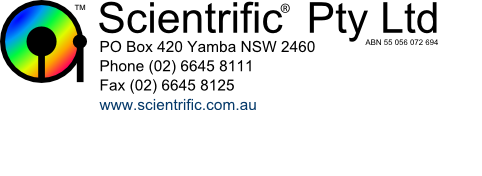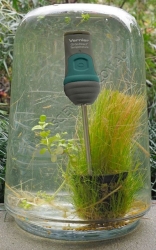
Enlarge
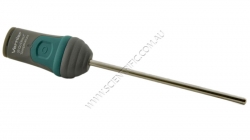
GDX-TMP
Enlarge
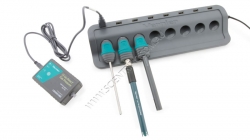
Purchase GDX-CRG to recharge multiple Go Direct sensors
Enlarge

Enlarge
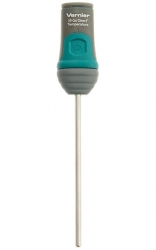
Enlarge

Enlarge

GDX-TMP
Enlarge

Purchase GDX-CRG to recharge multiple Go Direct sensors
Enlarge

Enlarge

Enlarge
Vernier Go Direct Temperature Probe
Order code: GDX-TMP
VERNIER GO DIRECT TEMPERATURE PROBE
Vernier's water resistant Go Direct Temperature Probe is a rugged, general purpose temperature sensor that students can use to monitor temperature. It connects wirelessly via Bluetooth® or it can be wired via USB to your device.
The Vernier Go Direct Temperature Probe gives students the advantage of go-anywhere, work-anywhere connectivity, its water resistance makes it the most durable Vernier temperature ever released.
Unlike a traditional thermometer, Go Direct Temperature allows students to collect real time temperature measurements of a single instance or over a period of time. Its temperature range and wireless capability make Go Direct Temperature the go-to sensor for real world applications.
The Go Direct Temperature Probe can be used in a variety of experiments:
• Conduct endothermic and exothermic reactions
• Investigate the freezing and melting of water
• Measure the energy content of foods
• Examine the absorption of radiant energy
• Monitor environmental conditions
Water Resistance:
The Go Direct Temperature Probe can be submerged in water for limited periods of time. It has been tested to a depth of one metre for up to 30 minutes. However, submerging the sensor impacts the radio operation by absorbing much of the energy. This may make it difficult or impossible to connect to the sensor while submerged, particularly if there are electrically noisy signals nearby, such as pumps or motors.
Rechargeable Battery — Ready When You Are
The Vernier Go Direct™ robust rechargeable battery offers long battery life and provides always-ready operation. Monitor battery life directly from Vernier's free Graphical Analysis™ app Should the battery run low simply connect the sensor to the charging cable and keep on collecting — no interruptions or inconvenience to you or your students.
Wired or Wireless — The Flexibility to Choose
Vernier's Go Direct™ sensors connect directly to your mobile device, Chromebook or computer using Vernier's free Graphical Analysis™ app. No additional equipment or software purchases are necessary. Vernier Go Direct sensors can be used wired via USB or wirelessly via Bluetooth allowing you to choose the solution best for your classroom or laboratory.
Vernier Graphical Analysis™ Pro includes all the features of the free Vernier Graphical Analysis app, plus enhanced functions for more advanced analysis. Its illustrative experiment videos and interactive graphing capabilities inspire students to explore crucial scientific concepts and analyze data in new complex and insightful ways.
Vernier Graphical Analysis™ Pro is compatible with most Vernier sensors and multiple operating systems and devices.
Specifications:
• Temperature range: –40 to 125°C
• Handle temperature range: –10 to 45°C
• Resolution: 0.07°C
• Connections:
Wireless: Bluetooth
Wired: USB
Included:
• Vernier Go Direct Temperature sensor
• Vernier micro USB cable
• Quick-start guide
Vernier Go Direct Temperature Teacher Pack GDX-TMP-TP
Buy more and save. With Vernier's Go Direct Temperature Teacher Pack you receive eight Vernier Go Direct Temperature Probes and a convenient charging station that allows you to charge eight Vernier Go Direct Temperature Probes at a time. The charging station is also compatible with many other Vernier Go Direct sensors
| User Manual | Vernier Go Direct Temperature Probe | ||
Educational use only:
Vernier and Kidwind products are designed for educational use. They are not appropriate for industrial, medical or commercial applications. Details
Warranty
- Warranty: 5 years (1 year on battery)
Dimensions- Package size (HxWxD): 25x127x203mm
- Packed weight: 70g
Last edited 9th Jan 2025
 This product is used in teaching these Australian Curriculum codes:
This product is used in teaching these Australian Curriculum codes:
ACSSU211 - Biological Sciences - Animal Survival - Living things live in different places where their needs are met
ACSSU187 - Chemical Sciences - Chemical Reactions - Different types of chemical reactions are used to produce a range of products and can occur at different rates
ACSSU189 - Earth and Space Sciences - Global Systems - Global systems, including the carbon cycle, rely on interactions involving the biosphere, lithosphere, hydrosphere and atmosphere
ACSBL019 - Biodiversity and the interconnectedness of life - Describing biodiversity - Ecosystems are diverse, composed of varied habitats and can be described in terms of their component species, species interactions and the abiotic factors that make up the environment
ACSBL021 - Biodiversity and the interconnectedness of life - Describing biodiversity - In addition to biotic factors, abiotic factors including climate and substrate can be used to and classify environments
ACSBL029 - Biodiversity and the interconnectedness of life - Ecosystem dynamics - Models of ecosystem interactions (for example, food webs, successional models) can be used to predict the impact of change and are based on interpretation of and extrapolation from sample data (for example, data derived from ecosystem surveying techniques
ACSBL047 - Cells and multicellular organism - Cells as the basis of life - Factors that affect exchange of materials across membranes include the surface-area-to-volume ratio of the cell, concentration gradients, and the physical and chemical nature of the materials being exchanged
ACSBL046 - Cells and multicellular organism - Cells as the basis of life - Movement of materials across membranes occurs via diffusion, osmosis, active transport and/or endocytosis
ACSBL045 - Cells and multicellular organism - Cells as the basis of life - The cell membrane separates the cell from its surroundings and controls the exchange of materials, including gases, nutrients and wastes, between the cell and its environment
ACSCH039 - Chemical fundamentals - Chemical reactions - A mole is a precisely defined quantity of matter equal to Avogadro’s number of particles; the mole concept and the Law of Conservation of Mass can be used to calculate the mass of reactants and products in a chemical reaction
ACSCH036 - Chemical fundamentals - Chemical reactions - All chemical reactions involve the creation of new substances and associated energy transformations, commonly observable as changes in the temperature of the surroundings and/or the emission of light
ACSCH037 - Chemical fundamentals - Chemical reactions - Endothermic and exothermic reactions can be explained in terms of the Law of Conservation of Energy and the breaking and reforming of bonds; heat energy released or absorbed can be represented in thermochemical equations
ACSCH026 - Chemical fundamentals - Properties and structure of materials - Differences in the properties of substances in a mixture, such as particle size, solubility, magnetism, density, electrostatic attraction, melting point and boiling point, can be used to separate them
ACSCH025 - Chemical fundamentals - Properties and structure of materials - Materials are either pure substances with distinct measurable properties (for example, melting and boiling point, reactivity, strength, density) or mixtures with properties dependent on the identity and relative amounts of the substances that make up the
ACSPH069 - Linear Motion and Waves - Waves - Waves may be represented by time and displacement wave diagrams and described in terms of relationships between measurable quantities, including period, amplitude, wavelength, frequency and velocity
ACSCH063 - Molecular interactions and reactions - Aqueous solutions and acidity - The concentration of a solution is defined as the amount of solute divided by the amount of solution; this can be represented in a variety of ways including by the number of moles of the solute per litre of solution (mol L1) and the mass of the solute pe
ACSCH065 - Molecular interactions and reactions - Aqueous solutions and acidity - The solubility of substances in water, including ionic and molecular substances, can be explained by the intermolecular forces between species in the substances and water molecules, and is affected by changes in temperature
ACSCH061 - Molecular interactions and reactions - Aqueous solutions and acidity - Water is a key substance in a range of chemical systems because of its unique properties, including its boiling point, density in solid and liquid phases, surface tension, and ability to act as a solvent
ACSCH060 - Molecular interactions and reactions - Intermolecular forces and gases - The behaviour of gases, including the qualitative relationships between pressure, temperature and volume, can be explained using kinetic theory
ACSCH073 - Molecular interactions and reactions - Rates of chemical reactions - Catalysts, including enzymes and metal nanoparticles, affect the rate of certain reactions by providing an alternative reaction pathway with a reduced activation energy, hence increasing the proportion of collisions that lead to a chemical change
ACSCH069 - Molecular interactions and reactions - Rates of chemical reactions - The rate of chemical reactions can be quantified by measuring the rate of formation of products or the depletion of reactants
ACSCH068 - Molecular interactions and reactions - Rates of chemical reactions - Varying the conditions present during chemical reactions can affect the rate of the reaction and in some cases the identity of the products
ACSPH020 - Thermal nuclear and electrical physics - Heating processes - Provided a substance does not change state, its temperature change is proportional to the amount of energy added to or removed from the substance; the constant of proportionality describes the heat capacity of the substance
ACSPH022 - Thermal nuclear and electrical physics - Heating processes - Two systems in contact transfer energy between particles so that eventually the systems reach the same temperature; that is, they are in thermal equilibrium
ACSCH102 - Equilibrium acids and redox reactions - Chemical equilibrium systems - Volumetric analysis methods involving acidbase reactions rely on the identification of an equivalence point by measuring the associated change in pH, using chemical indicators or pH meters, to reveal an observable end point
ACSBL115 - Maintaining the internal environment - Homeostasis - Animals, whether osmo-regulators or osmo-conformers, and plants, have various mechanisms to maintain water balance that involve structural features, and behavioural, physiological and homeostatic responses
ACSBL111 - Maintaining the internal environment - Homeostasis - Changes in an organism’s metabolic activity, in addition to structural features and changes in physiological processes and behaviour, enable the organism to maintain its internal environment within tolerance limits
ACSBL110 - Maintaining the internal environment - Homeostasis - Homeostasis involves a stimulus response model in which change in external or internal environmental conditions is detected and appropriate responses occur via negative feedback; in vertebrates, receptors and effectors are linked via a control centre by n
ACSCH131 - Structure synthesis and design - Chemical synthesis and design - Chemical synthesis involves the selection of particular reagents to form a product with specific properties (for example, pharmaceuticals, fuels, cosmetics, cleaning products)
ACSCH133 - Structure synthesis and design - Chemical synthesis and design - Designing chemical synthesis processes includes identifying reagents and reaction conditions in order to maximise yield and purity of product
ACSCH132 - Structure synthesis and design - Chemical synthesis and design - Designing chemical synthesis processes involves constructing reaction pathways that may include more than one chemical reaction
ACSCH134 - Structure synthesis and design - Chemical synthesis and design - The yield of a chemical synthesis reaction can be calculated by comparing stoichiometric quantities with actual quantities
ACSCH130 - Structure synthesis and design - Properties and structure of organic materials - Data from analytical techniques, including mass spectrometry, xray crystallography and infrared spectroscopy, can be used to determine the structure of organic molecules, often using evidence from more than one technique
ACSSU031 - Chemical Sciences - Materials - Different materials can be combined, including by mixing, for a particular purpose
ACSSU046 - Chemical Sciences - Solids Liquids Gases - A change of state between solid and liquid can be caused by adding or removing heat
ACSSU049 - Physical Sciences - Heat - Heat can be produced in many ways and can move from one object to another
ACSSU074 - Chemical Sciences - Materials - Natural and processed materials have a range of physical properties; These properties can influence their use
ACSSU043 - Biological Sciences - Adaptations - Living things have structural features and adaptations that help them to survive in their environment
ACSSU077 - Chemical Sciences - Solids Liquids Gases - Solids, liquids and gases have different observable properties and behave in different ways
ACSSU080 - Physical Sciences - Light and Sound - Light from a source forms shadows and can be absorbed, reflected and refracted
ACSSU095 - Chemical Sciences - Chemical Changes - Changes to materials can be reversible, such as melting, freezing, evaporating; or irreversible, such as burning and rusting
ACSSU149 - Biological Sciences - Cells - Cells are the basic units of living things and have specialised structures and functions
ACSSU176 - Biological Sciences - Ecology - Ecosystems consist of communities of interdependent organisms and abiotic components of the environment; matter and energy flow through these systems
ACSSU179 - Chemical Sciences - Chemical Reactions - Chemical reactions, including combustion and the reactions of acids, are important in both non-living and living systems and involve energy transfer
ACSSU004 - Earth and Space Sciences - Weather and Climate - Daily and seasonal changes in our environment, including the weather, affect everyday life
Click a curriculum code to see other products that relate.
| Accessories / Spare Parts: | From |
| GDX-CLAMP - Vernier Go Direct Sensor Clamp | $35.00 |
| CB-USB-MICRO - Vernier Micro USB Cable | $12.00 |
| CB-USB-C-MICRO - Vernier Micro USB-C Cable | $22.00 |
| GDX-BAT-300 - Vernier Go Direct 300mAH Replacement Battery | $25.00 |
| Works with: | From |
| GA4 - Vernier Graphical Analysis | |
| Similar Products: | From |
| GDX-WRT - Vernier Go Direct Wide Range Temperature Probe | $345.00 |
| GDX-ST - Vernier Go Direct Surface Temperature Sensor | $246.00 |
| GDX-PH - Vernier Go Direct pH Sensor | $271.00 |
| GDX-ACC - Vernier Go Direct Acceleration Sensor | $286.00 |
| GDX-FOR - Vernier Go Direct Force and Acceleration Sensor | $296.00 |
| GDX-FPH - Vernier Go Direct Tris Compatible Flat pH Sensor | $345.00 |
| GDX-GPH - Vernier Go Direct Glass-Body pH Sensor | $395.00 |
| GDX-CUR - Vernier Go Direct Current Probe | $246.00 |
| GDX-RB - Vernier Go Direct Respiration Belt | $311.00 |
| GDX-RMS - Vernier Go Direct Rotary Motion Sensor | $485.00 |
| GDX-3MG - Vernier Go Direct 3-Axis Magnetic Field Sensor | $246.00 |
| GDX-CON - Vernier Go Direct Conductivity Probe | $321.00 |
| GDX-COL - Vernier Go Direct Colorimeter | $336.00 |
| GDX-DC - Vernier Go Direct Drop Counter | $286.00 |
| GDX-GP - Vernier Go Direct Gas Pressure Sensor | $261.00 |
| GDX-LC - Vernier Go Direct Light and Colour Sensor | $246.00 |
| GDX-MD - Vernier Go Direct Motion Detector | $321.00 |
| GDX-ORP - Vernier Go Direct ORP Sensor | $296.00 |
| GDX-RAD - Vernier Go Direct Radiation Monitor - Geiger Counter | $544.00 |
| GDX-VOLT - Vernier Go Direct Voltage Probe | $236.00 |
| GDX-EA - Vernier Go Direct Electrode Amplifier | $196.00 |
Note: Prices do NOT include GST or freight


